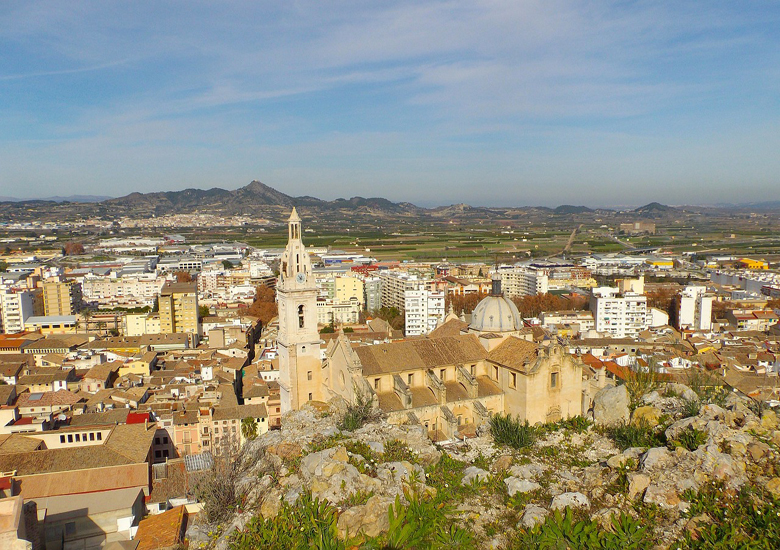Xativa is a small city in eastern Spain, in the province of Valencia, on the right (western) bank of the river Albaida.
Historically it was one of the most important cities of the medieval Kingdom of Valencia and the birthplace of the papal dynasty of Borgia and the composer Raymond. (1151), its historic center has several historic monuments such as its castle, the most important of the Kingdom of Valencia. The oldest paper mill in Europe is preserved in the city (1151). Its historic center presents several monuments of historical interest such as its castle, the most important of the Kingdom of Valencia.
The old town of Jativa was declared a Historic-Artistic Site in 1982, and it contains the great majority of the city’s heritage.
Access : Coordinates: 38.990278, -0.521111 / By train : 10 minutes from the historic centre is located The railway station , the city is connected with regional trains the cities of Valencia , Murcia, Cartagena , Alicante, Albacete , Ciudad Real, Teruel, Zaragoza and Huesca. Long-distance routes are links it to the south of France and Murcia.
, Valencia – Xativa is 49 minutes, with a frequency of trains every 20 minutes. (Xativa Train Station), Placa de la Estacion .
By car : Thanks to its location in the centre of the Region of Valencia ,From Valencia : For the Mediterranean highway A- 7 direction Alicante. Approx. journey time : 48 minutes.
From Madrid : On the eastern highway A-3 towards Alicante, join the A-35 towards Valencia. Approximate journey time : 3 hours 40 minutes. From barcelona : Connected through Northeast Highway A-2 . Approximate journey time: 4 hours.
By bus : From Valencia : Runs a daily bus , departing from Valencia at 10:00 and arriving in Xativa at 11:05. By air : The Manises airport is 8 km from the centre of Valencia. metro and line 5 bus service connects the airport and the city.
Highlights :
- Cova dels Lleons ( Cave of the Lions), small cave is said in popular folklore to have once contained lions. Sant Feliu / Torre del Sol ( Tower of the Sun ) , Moorish watchtower was built in the early 13th century , access on request / Castell de Xativa ( Castle of Xativa ), Calle Menor Cuesta, Xativa, summer Tu-Su 10:00-19:00 ,Winter Tu-Su 10:00-18:00 . Castle admission €2.40
- La Nevera (Ice House) , circular structure built , / Palau Arabe de la Aljama ( Moorish palace of Aljama )remains of a Moorish palace close Ermita de Sant Feliu. / Hospital Municipal , Founded as a royal hospital by Jaume I in 1244 , Plaza Calixto III / L’Almodi Museu Municipal ( The Almudin Municipal Museum ),No. 46, Carrer de la Corretgeria , Summer : 9:30 to 14:30 , September 16 to June 14)
Tuesdays to Fridays: 10:00 to 14:00 and 16:00 to 18:00 , Admission
Adults: €2.40 - Placa de la Trinitat square , this square is surrounded by spectacular buildings such as the Alarcon Palace, an 18th century mansion, and the 14th century Trinitat Convent. / No. 2, Av. de Selgas (Next to the Lion Fountain)
- Iglesia Sant Domenec , ancient Dominican convent was built between the 13th and 14th centuries at the behest of King Jaume II, No. 7, Calle Sant Domenec / Iglesia Sant Feliu , sant Feliu is one of the oldest churches of the Kingdom of Valencia. It was built in 1265 following the Christian conquest spearheaded by Jaume , Carretera del Castell , Winter:10:00 to 13:00 and 15:00 to 18:00. Summer 10:00 to 13:00 and 16:00 to 19:00. Sundays 10:00 to 13:00.
- Iglesia sant Francesc , Cistercian church built in the Gothic style in the second half of the 14th century , No. 10, Porta de Sant Francesc / Real Monasterio de Santa Clara , Gothic and Baroque styles, 14th-century
- Ermita de Santa Anna , Built in flamboyant Gothic style by Pope Alexander VI / The natal house of the Pope Alexander VI / Palau dels Borja ( The Palace of the Borgias ) The palace was constructed in the 15th century to be the residence of the Borgia family in the capital of the Kingdom of Valencia.
Events : Fira d’Agost ( August Festival ) annual event has been celebrated since 1250 , traditional song and dance performances , medieval market with handmade crafts, street food /
Festa del Corpus Christi ( Fiesta de Corpus Christi ) 60 days after Easter , Celebrated in Xativa since the 14th century / Falles (Fallas).15-19 March , With more than 150 years of tradition ,The Xativa Fallas are very popular, with 19 committees, and reflect local customs and cultural values. Together with the Other Towns, the Xativa festivities have been declared in 2016 Intangible Cultural Heritage of Humanity by UNESCO /
The Holy Week in Xativa , history in Xativa’s Holy Week celebrations, tracing its origins back to the 14th century, and is also one of the oldest in Spain.
Go next : Moixent / Ontinyent / Alcoi / Gandia / Denia

